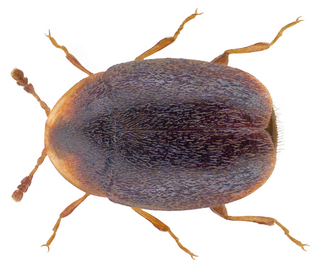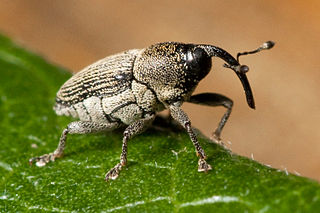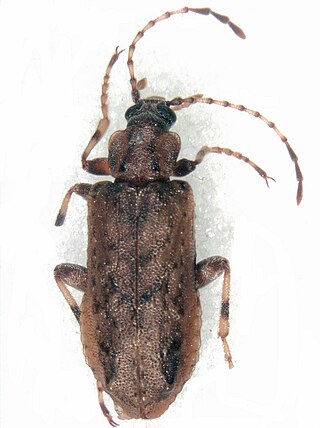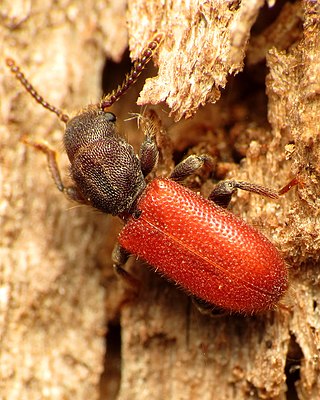
Corylophidae is a family of minute hooded beetles, sometimes called minute fungus beetles, in the superfamily Coccinelloidea. There are about 18 genera and at least 120 described species in Corylophidae. They feed on microfungi such as molds, and are often found associated with bark, as well as in leaf litter and other decaying vegetation. In older literature, the family name was often given as Orthoperidae.

Dryophilinae is a subfamily of death-watch and spider beetles in the family Ptinidae. There are at least six genera and two described species in Dryophilinae.

Ernobiinae is a subfamily of death-watch and spider beetles in the family Ptinidae. There are about 8 genera and at least 90 described species in Ernobiinae.

Mesocoelopodinae is a subfamily of death-watch and spider beetles in the family Ptinidae. There are at least 4 genera and 100 described species in Mesocoelopodinae.

Xenoscelinae is a subfamily of pleasing fungus beetles in the family Erotylidae. There are about 8 genera and 12 described species in Xenoscelinae.

Apostasimerini is a tribe of flower weevils in the family of beetles known as Curculionidae. There are over 240 genera and nearly 1700 described species in Apostasimerini.

Diaperini is a tribe of darkling beetles in the family Tenebrionidae. There are about 13 genera and at least 40 described species in Diaperini.

Cnodalonini is a tribe of darkling beetles in the family Tenebrionidae. There are about 13 genera and at least 20 described species in Cnodalonini.

Cryptophaginae is a subfamily of silken fungus beetles in the family Cryptophagidae. There are about 11 genera and more than 180 described species in Cryptophaginae.

Atomariini is a tribe of silken fungus beetles in the family Cryptophagidae. There are about 5 genera and at least 70 described species in Atomariini.

Phaleriini is a tribe of darkling beetles in the family Tenebrionidae. There are at least two genera and about six described species in Phaleriini.
Orthognathini is a tribe of true weevils in the family of beetles known as Curculionidae.

Merophysiinae is a subfamily of handsome fungus beetles in the family Endomychidae.
Prometopinae is a subfamily of sap-feeding beetles in the family Nitidulidae. There are about eight genera in Prometopinae, including one North American genus, Prometopia.

Agapytho is the only genus of beetles in the family Agapythidae. The genus contains a single species, Agapytho foveicollis, which is endemic to New Zealand. Larvae and adults are found on sooty mold growing on Nothofagus trees. Gut contents indicate that at least adult Agapytho consume the sooty mould as part of their diet.
Mauroniscidae is a family of cleroid beetles, formerly included in the family Melyridae. There are presently five or six genera and roughly 30 described species in Mauroniscidae, all of which are native to the Americas. Almost nothing is known about their biology.

Myrabolia is the only genus in the beetle family Myraboliidae in the superfamily Cucujoidea. It has about 13 species, found in Australia. Adults and possibly larvae live under the bark of Eucalyptus trees.

Promecheilidae is a family of beetles in the superfamily Tenebrionoidea. Perimylopidae is considered a synonym. They are found in southern South America and associated archipelagos like South Georgia and the Falklands, New Zealand and Tasmania. Some species are associated tree ferns and moss-covered dead wood, and other forested habitats, while others are associated with peat bogs, grasslands and coastal habitats. They are probably phytophagus, feeding on lichen, moss, and other plant material.

Tasmosalpingus is the only genus in the beetle family Tasmosalpingidae. There are two species in Tasmosalpingus, found in Australia in Tasmania, Victoria and New South Wales. Adults have been collected using malaise traps, while a possible larval specimen was found under the bark of the podocarp Phyllocladus aspleniifolius. Gut contents indicate that they are mycophagous, feeding on fungal hyphae.

Thanerocleridae is a family of beetles belonging to the superfamily Cleroidea. It was formerly considered a subfamily of Cleridae, but was recently elevated to the rank of family. The family has 36 living species in 10 genera, which are found globally, mostly in low-latitude tropical regions, though the genus Zenodosus is found in temperate North America. Thaneroclerid species are likely all predatory both in adult and larval stages. They target small fungus and wood associated beetles, and are generally found in places where such beetles are likely to be found, typically tree associated habitats such as under bark, though some species occur in other locations such as termite nests.


















